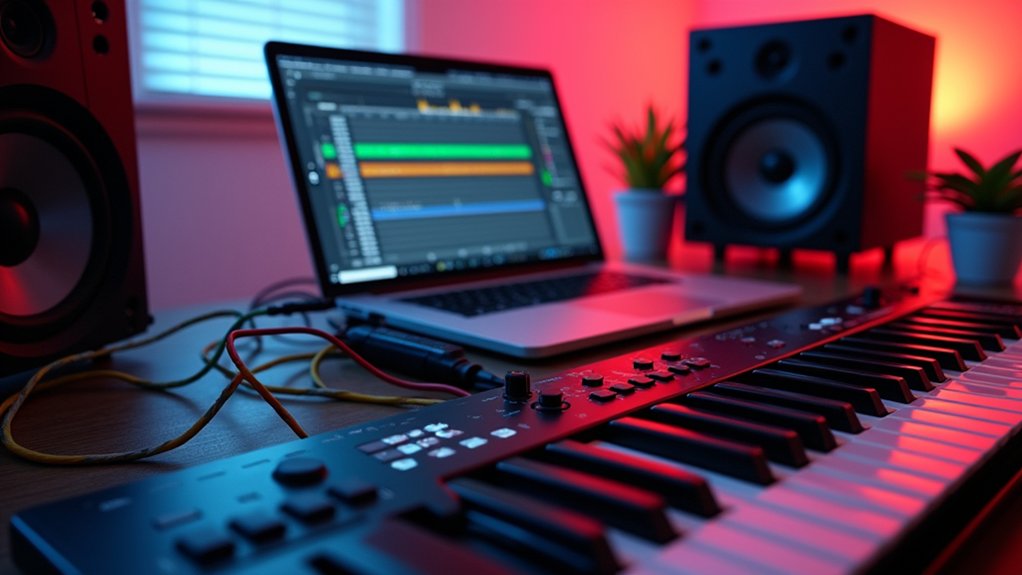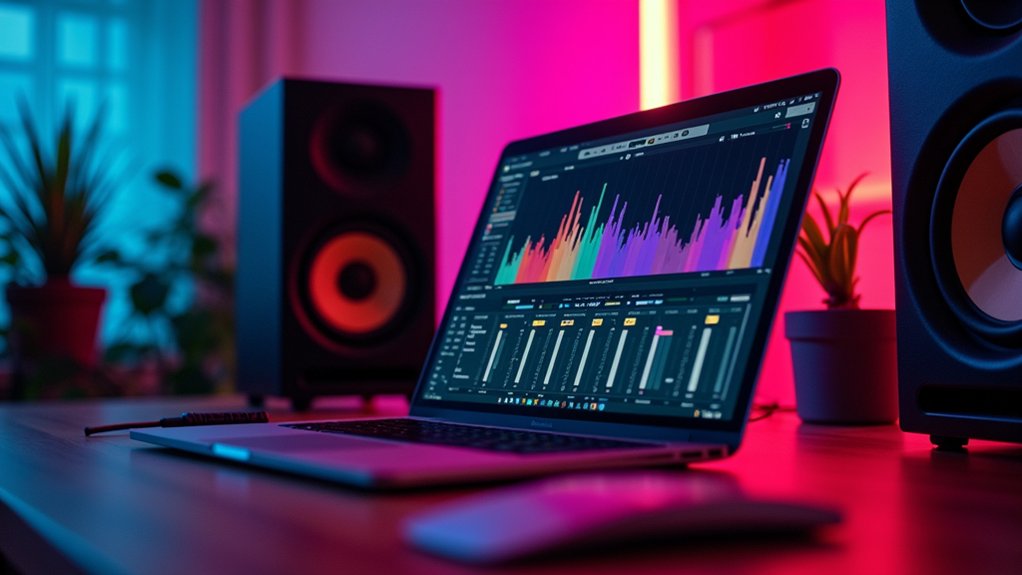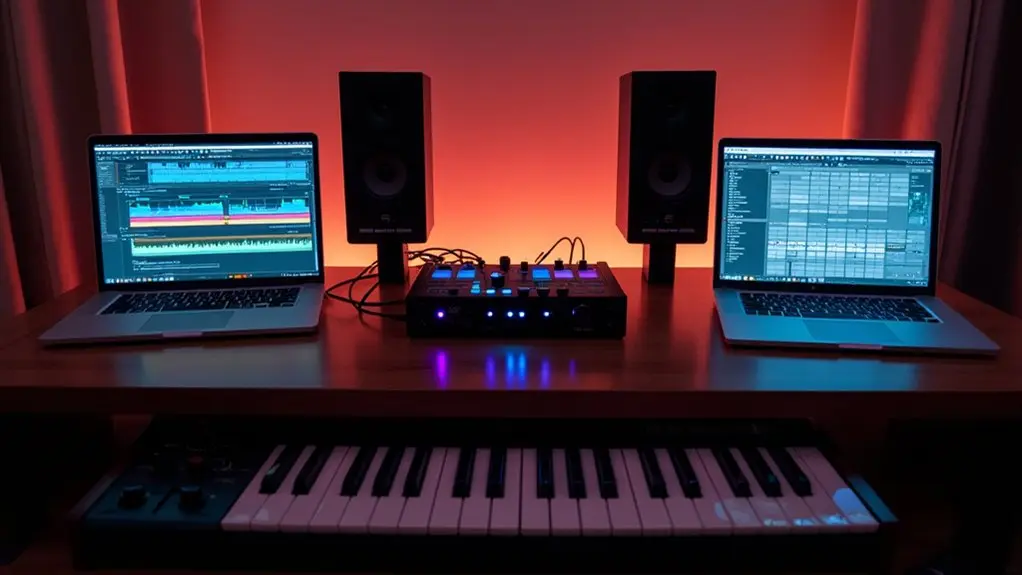Ableton’s Corpus effect models resonances from physical objects—beam, membrane, pipe, and more—to transform audio into intricate, harmonically enriched textures. Users manipulate size, material, and damping for timbral alteration while LFOs and stereo width add movement and dimension. MIDI-driven resonance enables pitch tracking and dynamic sidechain effects. Dry/wet blend and gain controls integrate processed signals tastefully within a mix. Advanced modulation and routing expand creative potential; further techniques reveal new sonic horizons.
Key Takeaways
- Experiment with different resonance types (beam, membrane, marimba, etc.) to transform ordinary sounds into unique, physically modeled textures.
- Use MIDI sidechain routing to trigger resonances melodically, adding harmonic layers or rhythmic accents to vocals, drums, or synths.
- Automate LFO parameters and resonance qualities to create evolving, movement-rich effects that add depth and interest over time.
- Blend dry/wet and stereo width controls for immersive, spatial effects while maintaining clarity and presence in the mix.
- Layer multiple Corpus instances with varied settings for dense, cinematic sound design or to emulate complex acoustic environments.
Exploring Corpus Resonance Types
Corpus offers seven resonance types, each algorithmically modeled to emulate distinct physical objects and their acoustic behaviors. These resonance types include models such as beam, marimba, string, membrane, plate, pipe, and tube, each imparting a unique set of acoustic characteristics to the sound output.
For instance, the membrane resonance simulates the vibrational response of a rectangular drumhead, introducing percussive timbres with characteristic tonal decay. Each type features dedicated parameters—such as size, construction, and material settings—that allow users to refine the sonic properties and resonance response.
Additional controls, including tube radius for pipe algorithms, provide further customization of the resonator’s acoustic profile. By selecting and tailoring these resonance types, users can achieve a broad palette of sound output, ranging from metallic to organic textures.
Setting Resonator Quality and CPU Optimization
After selecting and configuring resonance types to sculpt desired tonalities, attention must shift to the interplay between resonator quality settings and CPU optimization. Corpus allows users to modulate resonator quality via a dedicated control, directly influencing CPU usage and the fidelity of the audio signal. Lowering resonator quality minimizes processing demands, beneficial for projects with multiple Corpus instances or limited system resources. Conversely, higher settings yield rich harmonics at the cost of increased CPU usage. Each resonance type exhibits a unique impact on processing load, necessitating monitoring of Ableton’s CPU meter during adjustments. When managing such audio effects, freezing tracks can significantly reduce CPU load by temporarily rendering tracks to audio, thus improving performance. The following table illustrates the trade-offs:
| Resonator Quality | CPU Usage | Audio Signal Detail |
|---|---|---|
| Low | Minimal | Basic |
| Medium | Moderate | Enhanced |
| High | Significant | Maximum |
Shaping Sound With Size and Construction Controls
Sound sculpting within Ableton’s Resonator Effect hinges on precise manipulation of size and construction controls, parameters that directly define the resonance characteristics of each model.
Each of the seven resonance types in Corpus responds dynamically to adjustments in size, yielding a broad spectrum of sonic textures. For example, modifying the membrane resonator’s dimensions alters pitch and tonal color, while pipe resonators respond to tube radius changes, shifting timbre from bright to subdued.
Construction options enable users to toggle between basic and full processing, impacting both the complexity of the resonance and CPU load. Additionally, parameters like material type and damping further refine the resulting sound, providing granular control over resonance behavior.
Ableton Sampler’s advanced looping capabilities allow for seamless audio integration, paralleling the intricate manipulation possible with Corpus. These controls collectively facilitate intricate, process-driven sound design workflows within Ableton.
Enhancing Movement Using the LFO
Employing the LFO within Ableton’s Corpus enables synchronization of modulation rate to project tempo, ensuring rhythmic coherence with the track.
By adjusting phase and offset parameters, users can manipulate the stereo image, generating movement across left and right channels.
This approach introduces evolving resonance effects and spatial complexity, enhancing the perceived depth of the sound.
Syncing LFO to Tempo
When the LFO in Ableton’s Corpus device is synced to the project tempo, rhythmic modulation becomes tightly integrated with the track’s timing, enabling resonant effects to pulse or evolve in precise relation to the beat.
By adjusting the LFO rate in BPM or milliseconds, users can modulate resonance at different frequencies, shaping the spectral movement of sounds processed through Corpus on both audio and MIDI tracks.
The LFO’s waveform selection—such as sine or square—determines the contour of modulation, offering either smooth undulations or abrupt shifts in resonator parameters.
Syncing the LFO guarantees that modulations remain consistent across looped sections, facilitating precise rhythmic interplay.
For static resonance, disabling the LFO isolates the resonator effect, removing temporal modulation entirely from the audio signal chain.
Stereo Phase Manipulation
Although the LFO in Ableton’s Corpus device is often used for basic modulation, its phase and offset parameters offer advanced control over stereo imaging. By adjusting the phase, users can introduce time shifts between the LFO signals applied to the left and right stereo channels, resulting in pronounced movement and widening effects.
The offset parameter further refines this spatial manipulation by altering the starting point of the modulation across channels. Customizing the LFO’s shape and rate, and syncing it to project tempo, enables the creation of rhythmic modulation effects that evolve dynamically within the stereo field.
Experimentation with these controls produces immersive stereo imaging, as the resonator’s frequency modulation becomes a source of spatial depth, enhancing the perceived width and complexity of the audio signal.
Fine-Tuning Frequency With Filter Controls
How does one achieve precise spectral shaping within Ableton’s Resonator effect? The answer lies in mastering the filter controls, which directly influence the tonal content of the resonated signal.
By activating the filter via the yellow icon, users gain access to dynamic manipulation of the acoustic character. Adjustments are performed visually, enabling fine-tuned frequency targeting and attenuation.
Additionally, stereo width can be expanded, creating a spacious sound field and enhancing stereo image. Gain control is essential for managing the level of the processed signal, ensuring it integrates seamlessly within the mix.
- Activate the filter using the yellow icon for spectral modification.
- Drag circles or rectangles to adjust filter characteristics visually.
- Use stereo width to enhance the spatial dimension of the signal.
- Employ gain control to optimize the processed output’s volume.
Balancing Processed and Dry Signals
After precise spectral shaping with filter controls, attention shifts to managing the relationship between the processed resonated signal and the original audio. Central to this process is the dry/wet knob, which dictates the blend between the dry signal and the processed signal. Careful adjustment of this parameter guarantees the resonator effect integrates fluidly within the mix, preventing the processed signal from overshadowing the source material. Gain staging is equally essential; it avoids level imbalances that can obscure clarity. Experimentation with resonance types and quality settings further refines tonal complementarity. Additionally, leveraging True Peak Meters on the master bus can effectively monitor inter-sample peaks, ensuring the signal maintains clarity and avoids distortion. The following table summarizes key aspects of balancing processed and dry signals:
| Parameter | Role in Signal Balance |
|---|---|
| Dry/Wet Knob | Sets processed/dry blend |
| Gain | Maintains output level consistency |
| Resonance Type | Shapes timbral interaction |
| Quality Setting | Controls effect transparency |
| Level Monitoring | Preserves dynamic integrity |
Crafting Sonic Space With Stereo Width and Bleed
When manipulating resonated audio in Ableton, spatial perception becomes a critical dimension of the mix. The Corpus device’s stereo width control enables users to manipulate the perceived breadth of the resonated signal, adjusting from narrow, mono-centric sounds to expansive stereo images.
Alongside this, the bleed parameter allows precise blending of the dry signal with the processed output, preserving sonic clarity while enhancing resonance. Mastering these parameters is essential for shaping a compelling sonic environment.
To optimize these aspects:
- Increase stereo width to create a larger spatial field, enhancing immersion.
- Reduce width for focused, mono-compatible placement in dense mixes.
- Adjust bleed to retain articulation from the original signal.
- Combine subtle width and bleed settings for atmospheric textures that remain clear within the mix.
Using Sidechain for MIDI-Driven Resonance
Sidechain routing in Ableton’s Corpus enables resonance to be triggered directly by MIDI input, aligning the effect’s activation with precise note events.
By utilizing pitch tracking techniques, the resonance can follow the MIDI note’s frequency for harmonically integrated sound shaping.
Prioritizing MIDI note input within the sidechain settings guarantees that the most musically relevant pitches define the resonance behavior.
Triggering Resonance With MIDI
MIDI-driven resonance introduces a dynamic layer of control within Ableton’s Corpus device through utilizing sidechain functionality to synchronize resonance effects with MIDI note input.
By routing a MIDI clip to Corpus’s sidechain, users can trigger the resonator in real time, enabling intricate rhythmic and melodic interplay between incoming audio and MIDI notes.
The setup process is systematic and precise:
- Access the sidechain menu by clicking the triangle in the Corpus audio effect title bar.
- Assign a MIDI clip or external MIDI source to the sidechain input.
- Adjust the priority settings to specify which MIDI notes govern the resonance activation, especially crucial in dense MIDI arrangements.
- Experiment with MIDI note patterns to shape dynamic resonance that responds directly to musical phrasing.
This approach yields sound-oriented, MIDI-reactive resonance control.
Pitch Tracking Sidechain Techniques
Building upon the integration of MIDI control within Corpus, pitch tracking sidechain techniques offer a refined method for synchronizing resonance with specific MIDI note input. In Ableton Live, practitioners select a MIDI source as the sidechain input within Corpus, enabling resonance frequency to follow the incoming MIDI notes dynamically. To make sure the effect is responsive, configure sidechain settings so resonance activates and decays precisely with MIDI note on/off events. Utilizing the info view in Ableton Live provides guidance for ideal setup. Experimentation with Corpus’s resonance types reveals unique tonalities when pitch tracking is engaged. Additionally, combining the LFO with MIDI-driven sidechain introduces evolving textures. The table below visualizes the workflow and signal flow:
| Step | Action | Result |
|---|---|---|
| 1 | Select MIDI Source | Pitch-driven resonance |
| 2 | Enable Sidechain | MIDI-note synchronization |
| 3 | Adjust Decay | Responsive triggers |
| 4 | Set Resonance Type | Unique tonal character |
| 5 | Modulate with LFO | Evolving textures |
Prioritizing MIDI Note Input
When configuring Corpus for MIDI-driven resonance, assigning MIDI note input as the controlling parameter via the sidechain feature is essential for precise resonator behavior.
This approach leverages MIDI signal priority to shape resonance dynamics, allowing users to dictate which notes exert the most influence over the effect. Activating the sidechain triangle in the Corpus title bar enables MIDI source selection, which in turn facilitates intricate note influence techniques.
The result is a highly responsive resonator, directly following the input’s pitch and rhythm for more musical outcomes.
- Access the sidechain panel and select a relevant MIDI source.
- Adjust MIDI signal priority so key notes dominate resonance behavior.
- Fine-tune sidechain parameters to optimize resonance dynamics.
- Experiment with different note influence techniques for creative sound shaping.
Creative Sound Design Techniques With Corpus
Sculpting innovative timbres with Ableton’s Corpus device involves deliberate manipulation of its seven resonance types, each emulating distinct physical objects such as membranes or tubes.
By employing resonator layering techniques, sound designers can stack multiple Corpus instances, each tuned to different resonance models, to create complex spectral interactions and novel harmonic textures.
Applying Corpus to unconventional sound sources—such as percussive noise bursts or field recordings—yields unexpected tonal artifacts and metallic overtones, extending the sonic palette beyond traditional synthesis.
Dynamic modulation ideas arise from automating LFO settings linked to resonator frequency and filter parameters, resulting in evolving, morphing soundscapes.
Utilizing the sidechain MIDI input further enables rhythmic and pitch-based reactivity, while careful balancing of the dry/wet mix guarantees seamless integration within diverse production contexts.
Musical Examples: Transforming Loops and Instruments
Harnessing the Resonator effect in Ableton enables precise transformation of audio material by directly shaping harmonic content and rhythmic feel.
Employing targeted loop transformation techniques, producers can manipulate drum loops with the membrane resonance type, simulating drumhead acoustics and enriching percussive depth.
Rhythmic enhancement methods include applying MIDI-triggered sidechain resonance to vocal tracks for tight integration with groove elements.
Instrument layering strategies are demonstrated by combining distinct resonance types—such as marimba and guitar—resulting in a harmonically dense texture.
Dynamic soundscapes arise from frequency modulation, where LFOs evolve synth pad timbres over time.
Tonal sculpting is further achieved through meticulous filter adjustments on basslines, amplifying low-end presence.
For those aiming to achieve professional sound quality, incorporating Essential Mixing Tools like the FabFilter Pro-Q 3 can drastically improve mix clarity and cohesion.
- Apply membrane resonance to drum loops.
- Modulate synth pads with LFOs.
- Layer instruments using varied resonance types.
- Trigger vocal resonance via MIDI sidechain.
Frequently Asked Questions
How to Use an Ableton Resonator?
To use an Ableton resonator, one adjusts resonator settings such as resonance type, quality, and dry/wet balance. Creative modulation with LFOs and MIDI sidechain enables intricate sound design, enhancing tonal shaping and rhythmic complexity within audio processing.
How to Use Corpus Ableton?
To use Corpus in Ableton, users adjust Corpus settings such as resonance type, LFO modulation, and filter controls. Creative applications include enhancing timbre and adding movement, making it a powerful tool for experimental sound design workflows.
What Is Resonance in Ableton?
Resonance in Ableton, grounded in resonance theory, refers to amplifying specific audio frequencies to simulate natural or artificial acoustic environments. This sound manipulation technique shapes timbre, emphasizing harmonics and creating distinctive sonic characteristics within a digital audio workflow.
What Is a Resonator Audio Effect?
A resonator audio effect employs resonator sound design to simulate physical resonant bodies, enabling creative processing and advanced audio manipulation techniques. It alters input signals by imparting acoustic characteristics, supporting modulation, filtering, and dynamic control for unique sonic textures.
Conclusion
In conclusion, Ableton’s Corpus effect offers a versatile palette of resonant timbres through its nuanced resonance types and precise control parameters. By utilizing LFO modulation, filter shaping, and stereo processing, producers can sculpt unique textures and enhance spatial characteristics. Integration of MIDI sidechaining further expands creative potential, enabling dynamic, responsive sound design. Mastery of Corpus’s construction, frequency, and modulation functions empowers users to transform ordinary audio and MIDI material into complex, evolving sonic environments within their productions.




